JONATAN SPEJLBORG IN CONVERSATION WITH TRAVIS WYCHE
Goodiepal is a Faroese sound artist. He has been around for many years, performing for a long time as a solo artist in all sorts of genres, but definitely within computer music. He was part of the founding of the Danish Institute for Electronic Music. He has always been — in a very artistic way — an activist in his works and within the art field in a very avant garde manner. This group came about some years ago called Goodiepal and Pals, which is him and a bunch of other people. It has changed a little bit who’s involved, but Goodiepal and a few others have been there from the beginning. They are a hybrid form of social collective, both a techno-folk music group and a refugee organization. They’ve been in Serbia helping refugees at the European borders. I think they do really amazing work on many different levels, both artistically and in addressing a lot of important social questions. They hold the ethics of all these questions in a very beautiful way and place their bodies in relation to these questions in very interesting ways.

Long story short, a friend of theirs wrote me and asked if I wanted to set up a concert with them very close to where we live and we said, “yeah sure, that’d be great.” So we did that the last couple of days; just practical stuff like finding a drum kit and a mixer and some speakers and inviting people. The concert was yesterday and it was really, really good. They performed a score that consisted of 21 breaks. The notation is the breaks. All the breaks have been notated in the sense that it has been described in each break what each break consists of. In between the breaks they had their repertoire of texts, lyrics and melodies. There was one melody that was repeated over and over again in between these 21 breaks, so it felt like one song. The performance was a little over an hour and it worked really well. I enjoyed it so much.

I love the idea that the notation is the absence. The breaks are like the space to breathe; it’s the negative space that was notated.
The score notated that in one break the performers were to discuss within the group what to do after the break. They had this long discussion about what to play after the break, in the break. Another break instruction was to take a little nap. During another a performer took a little bike ride outside. He went out and took a bike ride around the building and then came back in. I’m not sure how elaborate or how precise the breaks were described in the actual notation, but the way that they were interpreted and performed was really good.

Then we went to this dubstep party out in the forest afterwards. It was quite a night! I remember from living in Aarhus that there was a little bit of a reggae dubstep vibe to the city, all focused around this guy named Nick. I remember he built sound systems and he still does. He moved out to a place in the forest close to the sea, out here very close to where we live now. Every year for six years he’s had a mini festival that lasts for almost a week where something like 100 people come from these dubstep communities spread around Denmark. Nick set up an enormous sound system and I really paid attention to the whole configuration of the music area. The DJs were in the back of the room and the sound system was on the front stage so that people danced with their attention to the sound system. People seemed to be worshiping the sound system, not the DJ. When the DJs performed, they seemed to make music for the speakers and not so much for the audience. It was all about these sound systems. I really liked it.

I was very fascinated in building giant sound systems like that when I was young. I would go to concerts of music that I was not particularly interested in just because — especially in the electronic music culture — the sound systems become monuments to sound. They would often incorporate exotic fidelities of speakers — very large subwoofers and very finely tuned tweeters — where you’re able to experience a sonic architecture unlike anything that is possible anywhere else in this world. I’ve been to many concerts in my life seeking out that extreme range of fidelity.

The Hollywood Bowl an outdoor amphitheater concert venue in Los Angeles, is a built as a half dome like an egg that’s been cut in half. It has incredibly fine acoustics. As you walk around the theater, the sounds modulate in relation to your position, like how you will might hear different pitch frequencies as you turn your head from left to right. The audience area is a semi circle facing the dome, so the effects of the architecture render the effect of an altar or a monument. I’ve been to many concerts there, because sometimes you can attend for very cheap — like $5 for a standing position — and I would walk back and forth from one edge of the dome to the other to experience the different sounds that become available as you move closer and farther away from the sounds reflecting off of this giant cement bell. I learned a lot about my own sense of hearing from that building.
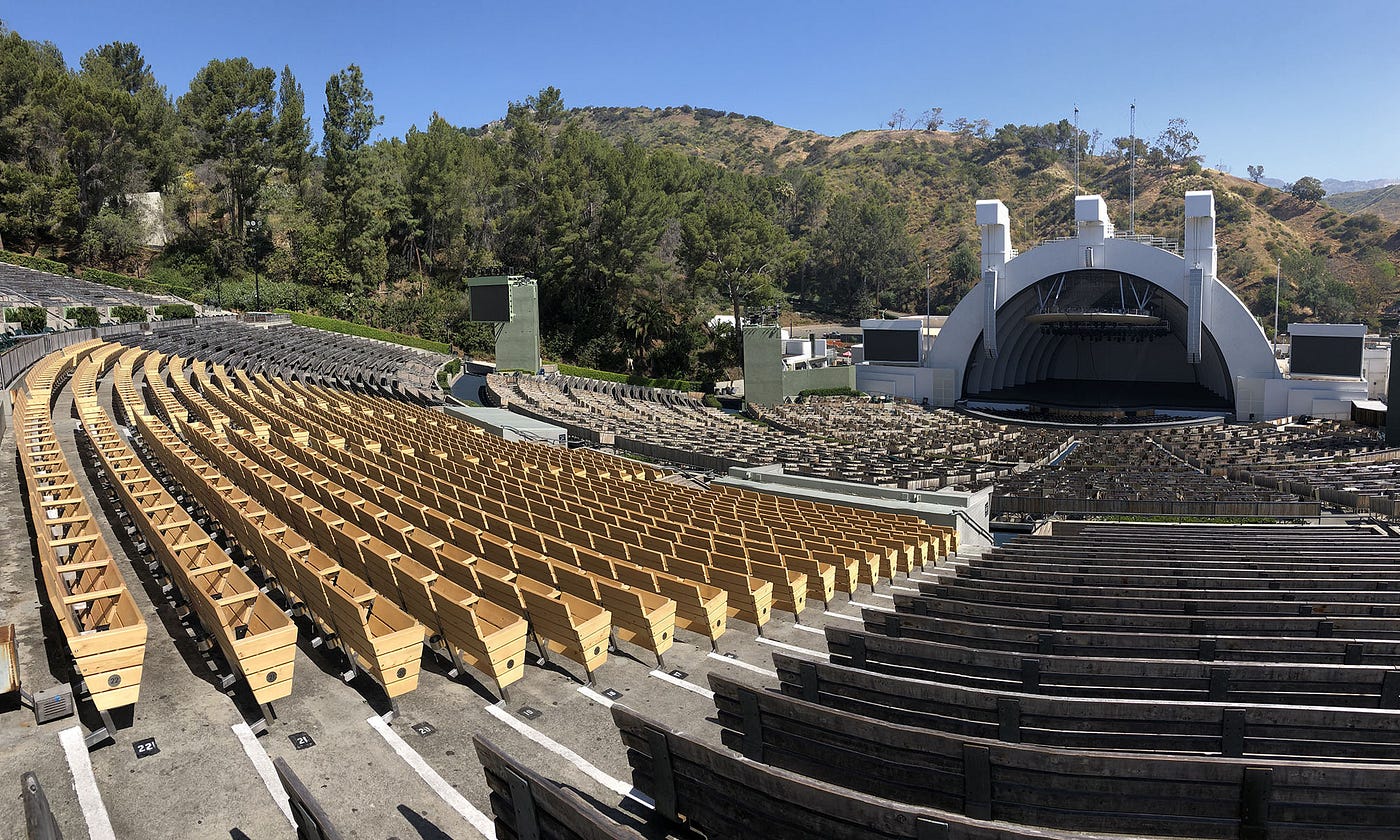
Do you know the band Sunn O)))? It’s pronounced sun and is an homage to the bands favorite amplifier company of the same name. They’re a heavy, dark, doomy drone metal band. I’ve seen them play many times. I find their music, quite honestly, to be a little boring, but their presentation is so incredible. There’s usually three to five guitarists circling around a pillar of giant amplifiers, the biggest amplifiers I’ve ever seen. Even though they hardly move there’s a spectacle of performance to it; they wear heavy robes and there’s a dark occult feeling. It’s a little cheesy too: fog machines and purple lights with this ominous, doom-laden guitar music. It’s like they’re worshiping, or sacrificing, to the gods of sound, or electricity itself amplified into an entity. It’s a very powerful experience to be exposed to. It’s visceral. It affects you in the gut. It influences your bodily organs; you have a corporeal reaction to music when it’s presented that way.

I like the situation of chamber plays, where so much is said in so few words. There are very few characters and when they say a sentence or two it contains so much that there has to be a little pause before someone responds to it. Not because what is said is very clever, but because there has to be some gaps in between the voices because the voices alone don’t convey the full experience. As a reader and as an audience to a text, you have to fill out these gaps. I say something, then the rest of what I say — which I don’t say — you have to, as the other voice, recognize what is being said by not being said, and then you have to respond. If we can get this text to somewhere like that, I think it would be great; full of holes that are that are full of tension!

That sense of tension resonates with me very deeply. I think that tension is the friction between two bodies that generates the kinetic energy that allows ideas to be integrated into one’s own life, into the reader’s perspective; to include them in the performance, but also to need them to fill in those holes, as a different kind of inclusion. The making of space, composing the negative spaces, is the inclusion.
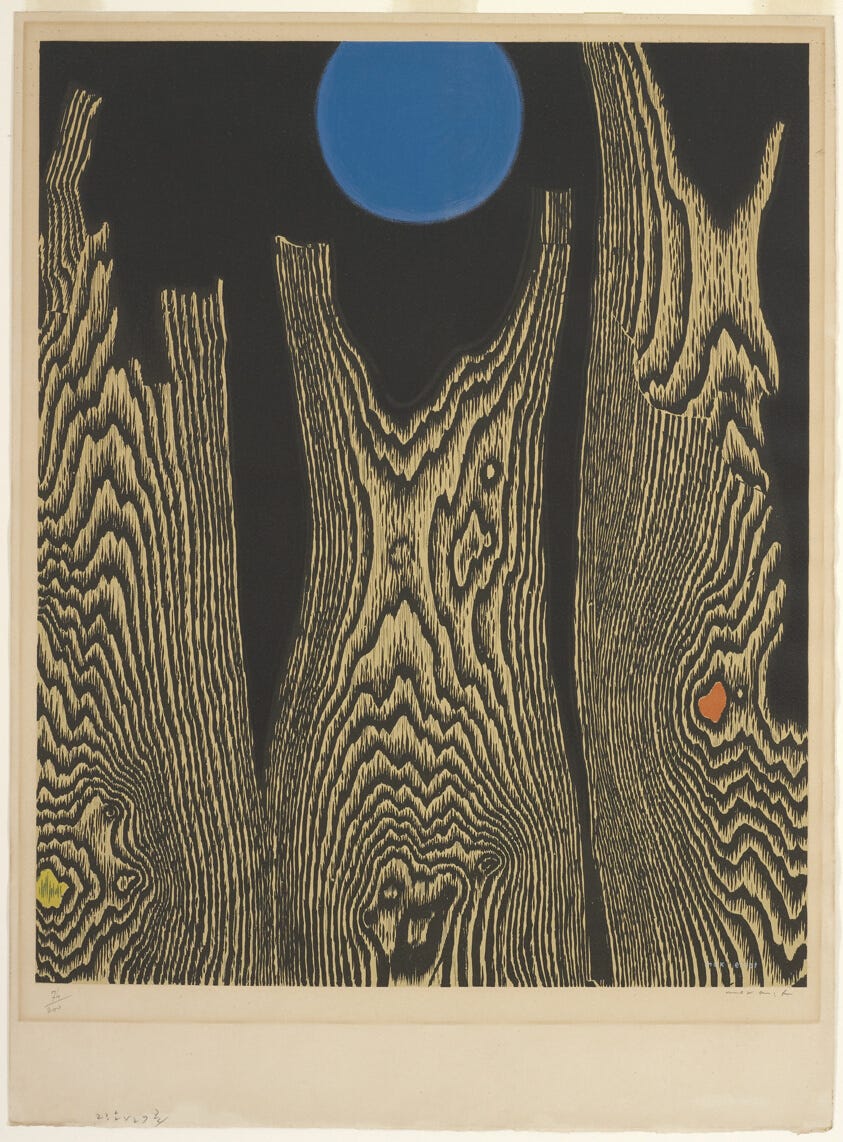
First of all, let me say *yes *to composing the negative spaces. Second, let me ask in the same breath, how do we compose this way? I would encourage us to refrain from answering that and offer that perhaps there’s a second part to this project. The first part is the composition, the notation, which we can perform verbally, theoretically, orally, and through the transcription, but then there will be the performance. How we choose to craft those holes in the making, in the praxis, in the action, will be important. I hope we can find a way to develop a manner of editing these texts together that does not feel like work, does not feel like a distraction, but feels like the chamber plays you mentioned. I want to swim around in the sammensurium with you and figure out how we perform these notations while remaining light and joyous.
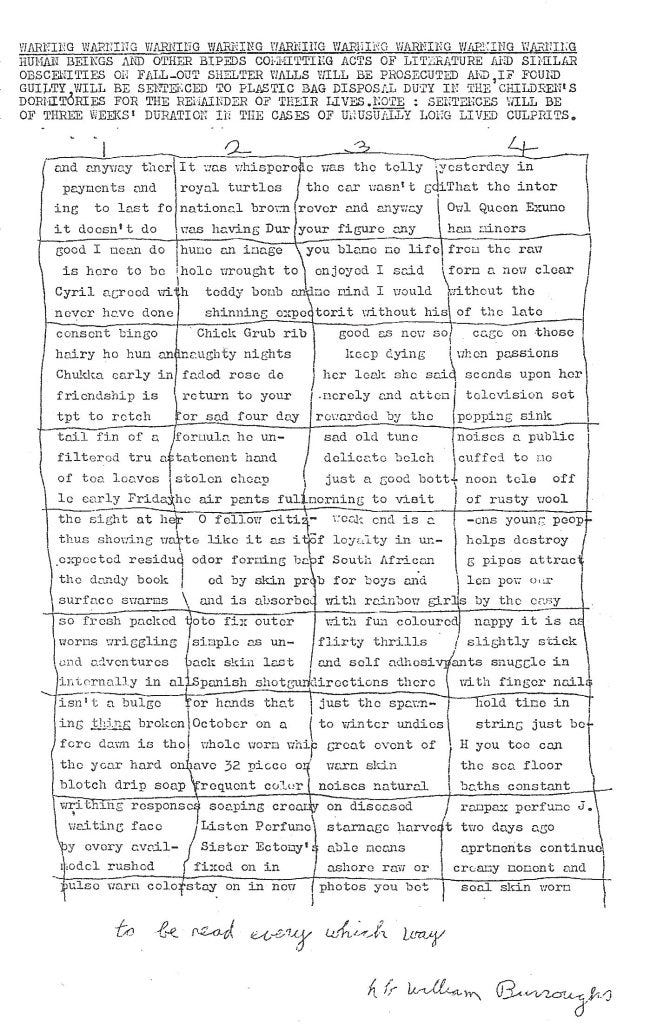
I have to say, my mood today is inflected by a very thick smoke outside. There are very large fires burning in California, Arizona, Idaho and in Southern New Mexico. They’re not nearby, but there are so many fires burning so intensely and there’s so much smoke in the air it’s as if all of my neighbors are having bonfires. The smoke flows thick through the windows and it’s agitating my respiratory system. I woke up with a bloody nose and my eyes are red and dry. There are warnings to not go outside because the air quality is very poor. We experienced a similar situation last summer. This is two years in a row that we’ve dealt with this horrible fire season.

I can’t shake this feeling that contemplations of the future carry a burden of the present crisis, this heavy weight of desperation. I am living currently within an ecological crisis and it’s inflecting the way that I think of utility and futility, of the potential to think of the future. I don’t want this project to speculate wildly, but to speculate ethically in consideration of these potential futures so that I can figure out a way to act appropriately. I’m not sure exactly how to address this. I have a couple of lines highlighted from this text. Escobar says:
Speculation is rampant in all kinds of directions and it might be useful to identify two opposing design fictions functioning as a heuristic with a whole range in between them. On one end, we have this matristic, convivial, futuring, and broadly speaking, a relational vision that highlights the re-creation of worlds based on a horizontal relation with all forms of life. The matristic approach respects the human embeddedness of the natural world. On the other end of the spectrum, there lies the dream held by the flashy techno fathers of the moment, of a post-human world wholy created by man. This is the world of synthetic biology, with its gene-centric view of life, of booming techno alchemies for genetic enhancement, and the prolongation of life, of robotics, cyborgian fantasies, space travel, nanotechnology, unlimited 3D printing, and much more, of all the bizarre geoengineering schemes concocted in corporate boardrooms as solutions to climate change, and of those advocating for the “great singularity,” a technologically induced transformation when humans transcend biology, in which life would finally be perfected, and perhaps, as in the world without mothers of artificial intelligence fictions, where women’s ability to give life is finally completely usurped by woman being wholly created by man through the machine.

The organization which I have received funding from is very much situated within this second camp of futurity. They are seemingly aligned with this synthetic, techno-alchemical, cyborgian fantasy of utopian technologies. And yet, I do hear voices rising from the chorus every once in a while that call out for the need to take up an ecological responsibility or a new ethics. There are individuals that are calling for an inclusive conversation that needs to be had. The reason I was attracted to the community is because I sensed a potential in what they were saying, how they were organizing, what they’re building, and the way that they’re building it. I sense a potential to move towards the matristic, as Escobar says, towards a more of a convivial futuring, to step into a more of a relational vision of the world.

They talk a lot about decentralization. That’s the core idea of the community. This is also the core idea that brought you to mind, because I think of all of your practices as being profoundly decentralized and very successful. You are one of the most successful coordinators that I’ve ever met, and in contemplating the metric for evaluating that success I sometimes become skeptical about the coordination efforts of the community that I’m becoming involved with. The question for me is: after we coordinate successfully, what purpose are we accomplishing? Alongside that, when does the ethical or the ecological or the sustainable futurity come into the equation? Is it forgivable or admissible to become obsessed with coordination itself, because that facilitates these other ideas to come later? Or must we refrain from becoming preoccupied with the means of production and focus upon the purpose of our productions? I question the utility of pure coordination. In fact, I would say that there is an inherent futility to such coordination efforts if they’re not driven by some kind of ethical or ecological or inclusive purpose.

I’ve been thinking a lot about that as well throughout my years of organizing. As an organizer, I consider the elements of production. There are aspects of the school and things within the school, particularly all the workshops, events, and all these little things that need to be produced. There’s a skill or craft in the production of making things work. I can feel that I’ve become significantly better at knowing how to do things efficiently and more effortlessly at the same time. There’s this streamlining that part of me is attracted to, like when things just click, when it just works and your plan can be executed in a way where things just fall into place. At the same time, I’m very skeptical towards that aspiration within myself. I think everything that is running smoothly must… maybe not everything, but close to everything, especially when we’re talking about organizations — but if it runs smoothly you can almost guarantee that there’s some kind of oppression going on. That’s also where the word sammensurium and the whole idea about messiness becomes really helpful.

When you talked about when we have organized successfully, I think it’s super important to discuss these success criteria. What is a successful organization if it’s not, as you say, coming out of a purpose? It can often become about the organization itself, about efficiency and productivity and similar metrics. The organization has to be for the sake of something else. I’m not organizing just to be efficient; that’s almost nonsense! At least it’s not rooted in any kind of values, any sort of ethical relation to anything. For me, it has really translated into trying to figure out how I can let go of these aspirations. In the beginning, when I wasn’t as experienced in organizing stuff, it came a little bit on its own, because the messiness was inexperienced.

We talked a little bit about obstacles in our last conversation. I really like to think of it as what obstacles can I introduce to trick myself into forgetting about efficiency for a while, to just nurture these ethical, cultural, social, and artistic aspects of what we’re doing? When they are nurtured and I let go of other stuff, it becomes a little bit more messy. I think one of the ways that it has happened over the years has been through different kinds of exhaustion. That’s why some of these 24-hours or two-days-without-sleep kind of situations can be very helpful because that almost necessarily brings about a little bit of messiness in thinking and doing, in my energy. Other forms of exhaustion have been really helpful, but that’s definitely not the only kind of obstacle and I don’t think it’s the healthiest form of obstacle if you continue to do it for a while.
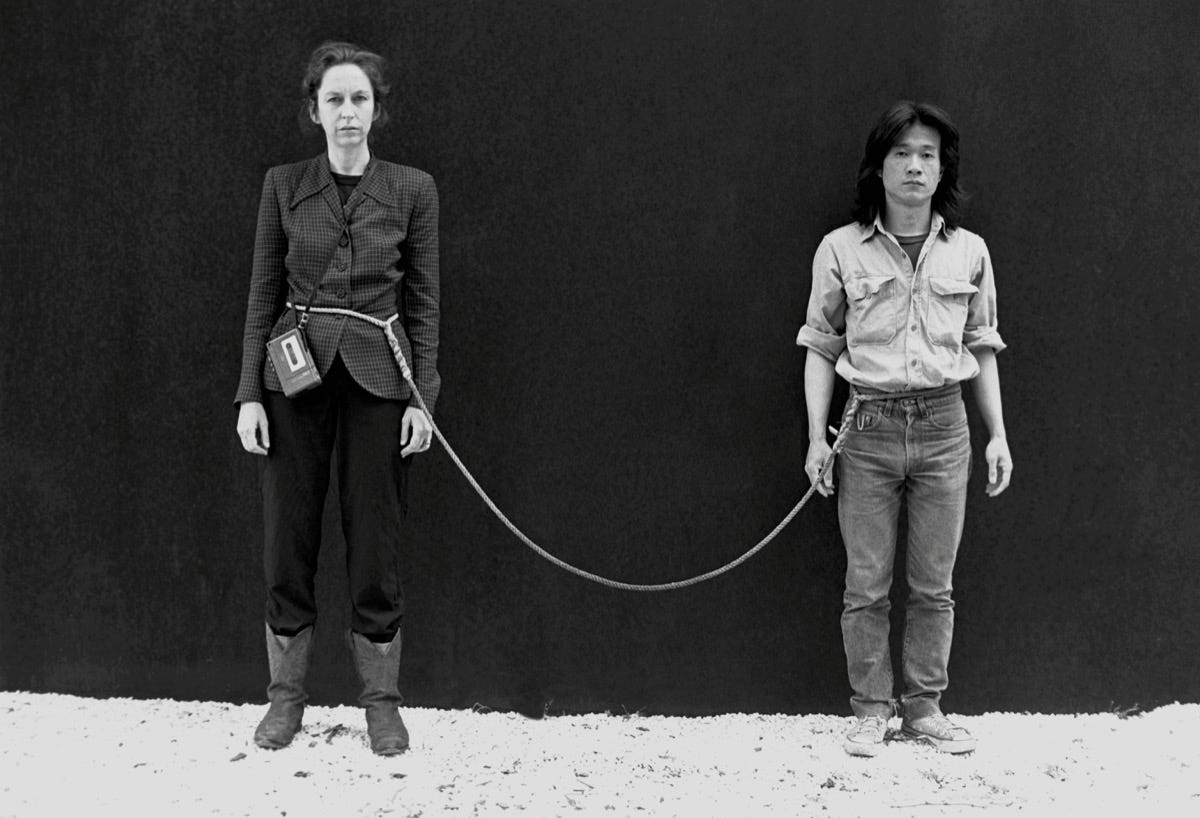
You’re using the word obstacle, but I remember us using the word constraint.
Yeah. Better word.
I like how you have supplemented this different word. It’s a different connotation for me, though. They are both a kind of impediment or inhibition. An obstacle, to me, feels like something that must be dissolved. It’s a problem. We also spoke a lot last week about education and the role of education in conversations like this and how it relates to the desire for efficiency, productivity, to streamline things, to maximize the results and ease the process flow. Striving for efficiency is what has driven industrial civilization to where we are today, and yet it’s an obstacle to being able to render the world the way that it needs to be seen. Efficiency itself is an obstacle that we must unlearn.

This is how I’ve been thinking about education this week, based on your prompt, in order to learn this way of creating space that allows for creativity, where we are performing a role that adds layers on top of our identities. It’s not separate and does not take away, but is somehow parallel, on top of and inside of at the same time. There’s so much we must unlearn. We must unlearn efficiency. We must unlearn these ways of knowing. We must unlearn the dualist ontology of separation and control and appropriation as this represents the dominant, patriarchal, capitalist modernity. We must do that in order to emphasize the profound relationality and interconnectedness that I would propose is required for successful coordination, according to my own metric, but also for survival, in order to allow the ethics that are devised to be relevant for the local performers. We must avoid this desire to speak the universal.
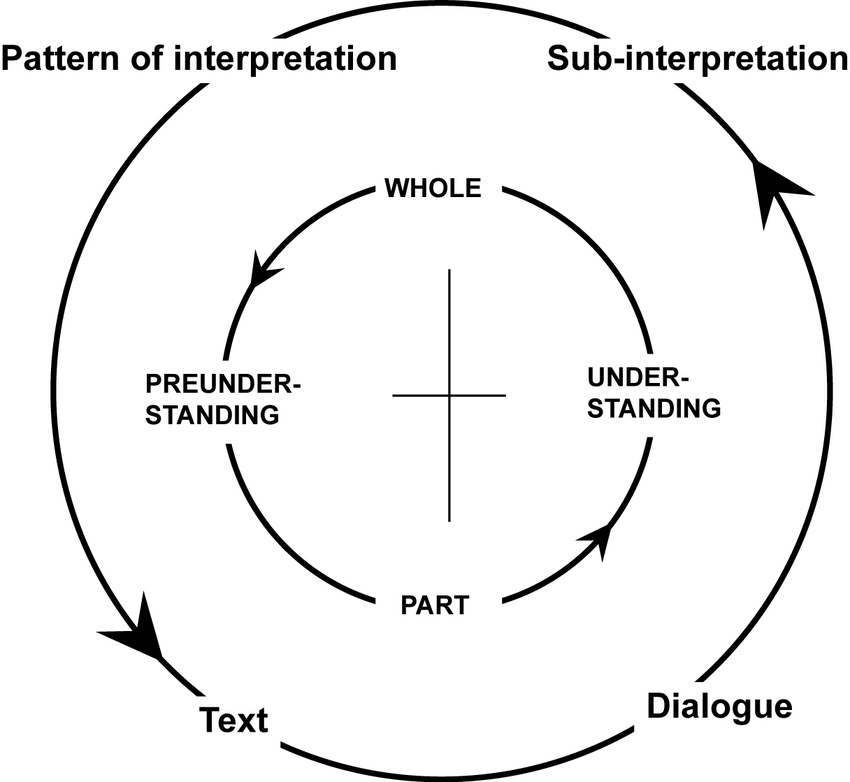
I imagine us being caught between two phases. I’ve encountered a lot of radical unlearning, but I’ve also encountered some radical obstacles as impediments to me being able to learn a different way. I think we are in a transitional time. Arturo Escobar mentions that in this transitional period, where we are seeking alternatives, we approach what we might call indigenous ways of knowing or what some have described as an archaic revival, of looking into our past and practicing unlearning as a form of remembering a way that we once lived and that was perhaps more harmonious or more balanced or closer to a state of equilibrium. I wonder about the ethics of this turn. We must not simply appropriate and incorporate this vision into our industrial processes. There’s a profound paradox that drives me mad and makes me feel hysterical in recognizing that there is this need to undo everything that I know without being able to supplement it with another form of knowing. I want to somehow soften in relation to this desire. I love to use this phrase existential agility. I think of it as aikido with oneself, to somehow catch and receive the destructive forces of the world and not to internalize them, not to absorb the blow and internalize the trauma, but to move in relation to it so that you’re able to redirect that energy, that motivation, that patriarchal empirical force back upon itself, so that it cracks under its own pressure.

I was talking to Lasse about some of the writing that I’ll be doing after the New Year concerning my dissertation. We were specifically talking about a project that happened in Iceland. A memorial service, a funeral, was created for a glacier a couple of years ago, because this glacier was declared dead some years before that. There were two American anthropologists who were doing research on the death of the glacier and the Icelandic relationship to the glaciers. Through their work — they do a lot of project-based stuff — they developed this project of making a funeral which consisted of a memorial service and a plate placed on a stone where the glacier was. This is going to be one of the case studies that I’ll be writing about on the topic of memorialization. For Lasse, it was very clear that a project like this reproduces the way that we already work with memory, of assigning something value, determining what’s good, of being in a position of saying that something has value. That whole idea of memorialization also reproduces some patriarchal hierarchies, regarding who gets to decide what has value and all the problems that are embedded in there. Lasse was arguing that practices like these, even though he can understand where they come from and what they hope to achieve, are in so many ways reproducing the relations that they attempt to undo.

The whole question about how to make a project that does not reproduce patterns of relations, but can somehow alter these relations within the frames of the project, seems so difficult to actually approach. I feel like many projects either deliberately avoid it or the route they decide to take becomes less about changing the relation in the first pass to just point out that something is relational. For example, this thing with the glacier: my experience is that this form of memorialization does not necessarily alter or reorient my relationship that I have with a glacier, but merely points that there is a relation. The project says that you and the glacier are related. If we’re generous in our way of looking at many of these projects, you could consider that a step in the direction going towards a matristic organizational structure, which amounts to a completely different relational ontology. I have a feeling that many who work with these things find it necessary to go through these steps, that first there needs to be a lot of pointing towards that there is a relation, before you can actively alter any relations. These projects also seem, in many ways, a little bit clumsy. I think the clumsiness is okay; if you’re honest that you’re clumsy, it’s a way of saying, “I can’t just step into another way of experiencing the world. How could I? I need to go through a lot of steps, to slowly move into another way of being, and that is clumsy.”
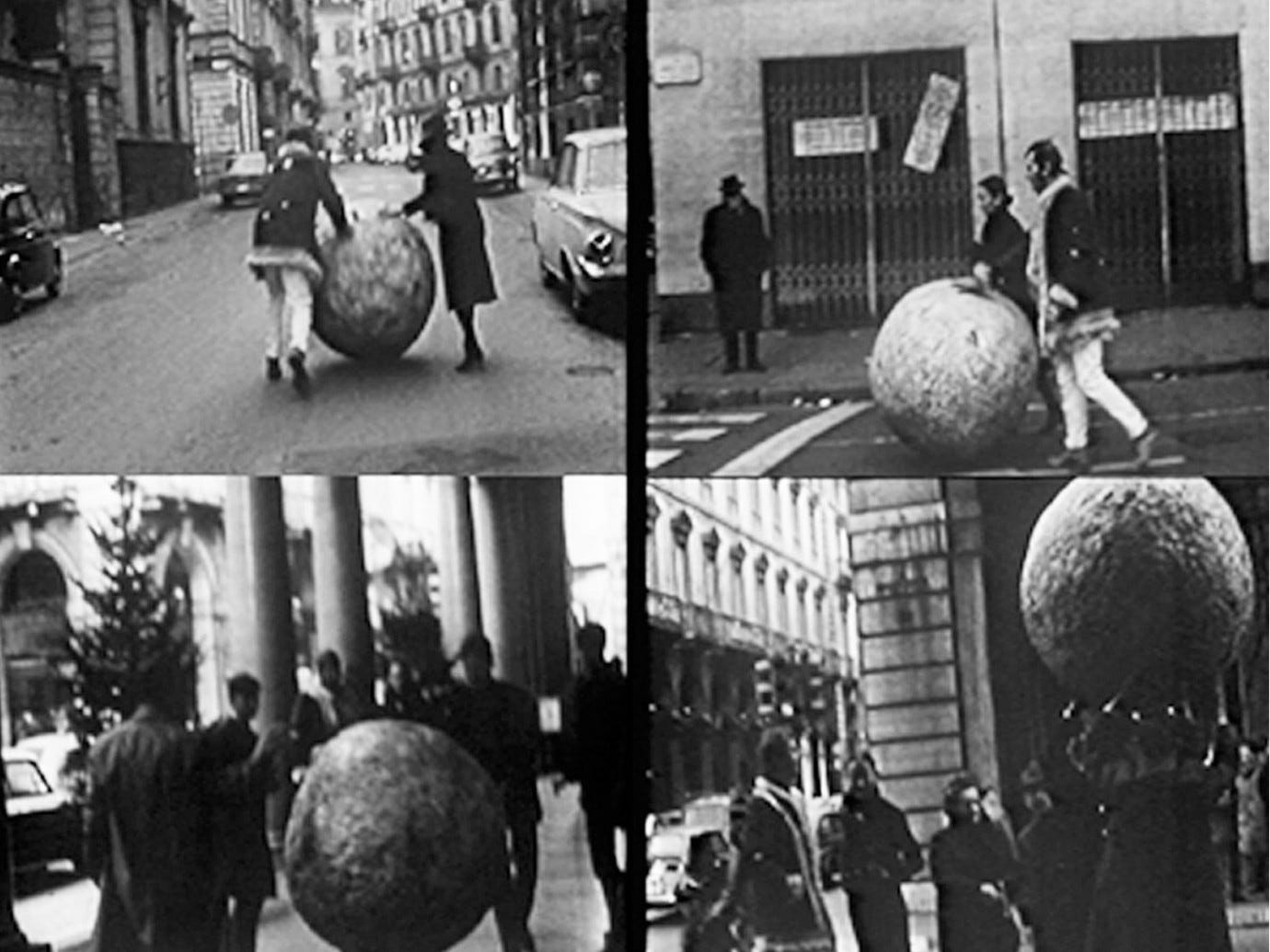
‘Clumsy’ evokes hand-eye coordination, elementary motor skills.
This is going to be sound cliche, but also like hand-heart-eye coordination. We need to nurture the relations that we carry with us between our ethics, our actions, our minds, and our perception. That’s going to be a clumsy practice for a long time.
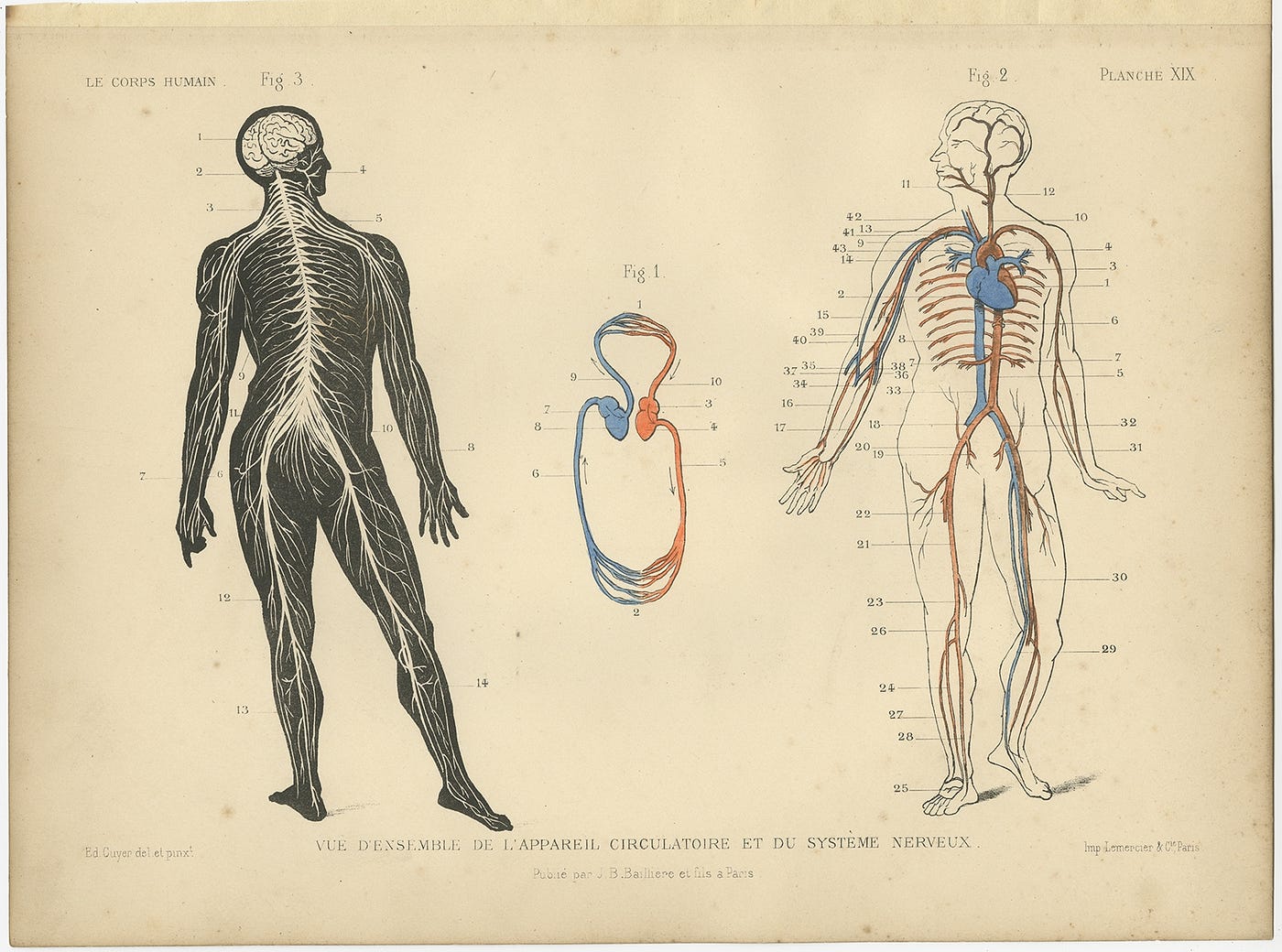
It’s almost like a stutter. Whether it’s a cultural stutter or a neurological stutter I’m not so sure, and what’s the difference anyways? If we’re thinking of ourselves in an expanded ecological network, as a networked self tethered to each other, are we stuttering on this notion because we don’t have the words? Is it a clumsiness like a jagged, percussive stuttering? To bring it back to the musical score, how do we notate the opportunity for the stutter so that we can embrace the clumsiness of the composition and somehow stir up a joyfulness in the collaboration? It really amounts to an encouragement to become more comfortable with the unknown and the unknowable. I’ve been meditating on this for many years. I have this half-baked opera written into the unknown and for the unknowable. This is also a meme within the tech culture. It’s almost spoken about in terms of Darwinian fitness, as in social Darwinism. Those that are the most fit and therefore the most efficient, the most likely to succeed, are those that are the most comfortable in dealing with the unknown, meaning the unexpected, but also just the unpredictable. This often amounts to a boldness, a fierceness, a blind courageousness when faced with the unknown, to plow into it rather belligerently. “Don’t let yourself be clumsy! Don’t trip! Continue to step boldly into that void!” That is a hubristic gesture, a belligerent gesture.
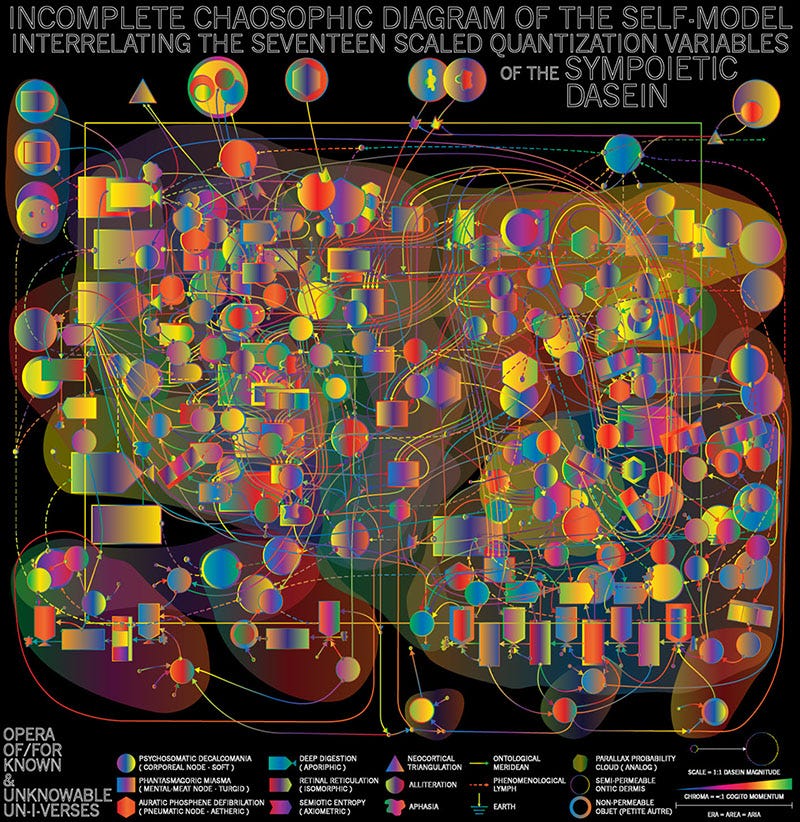
I don’t necessarily associate clumsiness with someone that is not aware of their body, but it does imply a little bit of flailing that requires a looseness of composure and a softening of being. Maybe that might amount to a composure of humility in the way that we take our stance, in relation to gravity. It doesn’t matter whether you march boldly in or clumsily fall, it’s still the same unknowable void. Maybe the first impression of how we fall in will color our understanding of everything that we discover in that void, within that space of unknowing. Maybe all we can do right now in this transitional period is focus upon our composure. I don’t think that it amounts to the same thing as obsessively focusing upon coordination though, or maybe it’s an inverse sense of coordination. We might become more focused upon coordination as a corporeal embodiment, as a motor skill or sensibility, or as you say, the eye-hand-heart coordination.
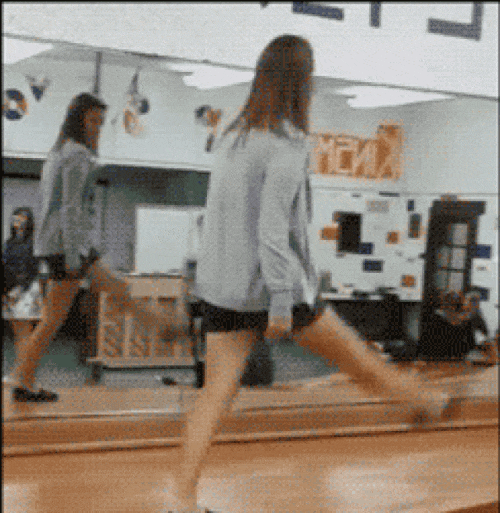
We must design ourselves before we really know how to show up for our relationships. We must figure out which way and which direction we’re going to step, as we were discussing last week; whether we’re going to step to the side or step back or step further into the mess. Each of us deciding individually is what creates the communal dance. It’s what orchestrates or notates the score of collective action, of collaborative play. I personally feel ill equipped to lecture on these ideas to others. I don’t want to position myself in a pedagogical manner, to educate as though I know better. This is another question when it comes to education. If it’s a matter of shifting our composure and focusing upon coordination in another way, how do we broach the subject with those that are moving so quickly, so boldly? How do we approach that conversation? How do we invite the other to slow down and to unlearn this preoccupation with efficiency and speed?

Agility is a buzzword within design. Agile design is a fast iterative design strategy with many things happening simultaneously that maximize the speed of us to be able to iterate on our ideas. As opposed to waterfall methods, where one idea comes before another and they cascade into each other. Waterfalls are linear. One thing happens, then the next thing, then the next thing. This is now associated with slow, dumb, centralized, old world design.

If we want to nurture this aspect of relationality, it requires acknowledging that this relation to the other is to some extent unknowable and often also unknown. It might be a first step to recognize that this relationship is there. I think there’s something about that organizational design that recognizes that it does not just require openness, it also requires openings. One word we might insert into our design principles could be something about openness instead of efficiency; that we don’t design to be efficient, but we design for openings. As an educator, the pedagogical aspects of designing for openings is really fun to think into. It’s full of questions and questioning. Designing for openings feels more fragile than simply agile. It’s not that you design a door, but you’re designed for the possibility of an opening. It’s inherently uncertain if it’s happening, if there are openings coming along. It has so much to do with holding space; the openness required to recognize an opening has a lot to do with the feeling of — I don’t know if it’s comfort or discomfort or whatever, it can be many things — but at least there’s some qualities to the space and the place that we talked about last time that can facilitate this possibility, or contribute to it. There’s so much pedagogical value and pedagogical practice within this.
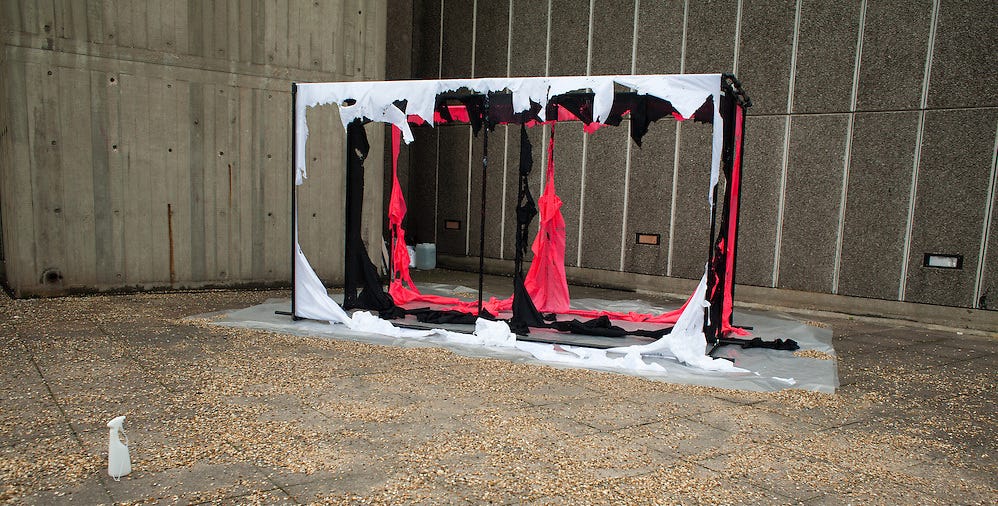
That pedagogical practice, in my mind, amounts to the articulation of a methodology. This is a concept that serves as an adhesive. Maybe it’s a rather elastic adhesive — it’s more rubber cement than it is gypsum cement — for binding together the need to ask how and the need to also be proactive in designing a relation to the crisis that is before us and that inhibits our ability to think futurity, to think speculatively. The pedagogical flavor that we add to our dough is the need to share it, to distribute it, and to be active in the making of these spaces together, recognizing that we cannot remain separate. The silos must be taken down or opened up. This is where the why meets the how, where the ethics meets the method, where the lesson is to unlearn, and yet we must continue to teach that teaching itself is not necessarily teaching more of the same. It requires a shift in our orientation to how we teach and what we teach and why we teach.

These are open questions! This conversation doesn’t necessarily allow me to understand how to do this any more clearly, but it does make me feel a bit more confident in attempting to exercise the humility required and to keep asking better questions and to try to lead us into the unknown without moving too quickly, and to let you lead also so that I can continue to feel disoriented and lost in order to find myself again. Is this unraveling or is this entangling? That’s the creative tension. Maybe it’s about stepping into the center of the muddy mass, to be thoroughly coated by it, to be thoroughly unseen or unseeable in the core of the sammensurium.
Maybe. Emphasis on maybe. Joyful maybe!

There have definitely been times where I’ve been really questioning whether educational practice makes sense to continue. What does it reproduce? What is it producing? These questions are very present from time to time and shed a lot of doubt, but they also have been the cause of a continuously renewed relationship to what it is and what’s happening around me. It feels like an ongoing conversation without really answering anything. Teaching itself does not necessarily mean having the answers and continuing to teach can be worthwhile in considering all these questions. This kind of relationship to these questions feels necessary to keep going. If it feels like it’s worthwhile to keep going, or that it could be worthwhile, then I’ll keep going. Overall, I have a feeling that the world is a place in which it can be worthwhile to keep going. My task is to figure out how. I’m up for failing quite a few times and throughout life — to stay clumsy — but I’m going to keep trying.
This series is made possible by a generous grant awarded by MolochDAO. Thank you Moloch!